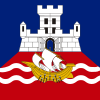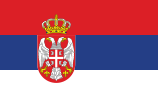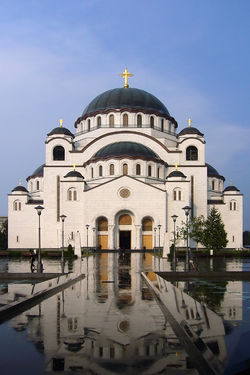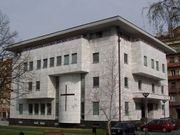Cathedral of Saint Sava
The Cathedral of Saint Sava (Serbian: Храм светог Саве or Hram svetog Save) is an Orthodox church in Belgrade, the capital of Serbia, and the largest Orthodox church building in the world[1]. The church is dedicated to Saint Sava, founder of the Serbian Orthodox Church and an important figure in medieval Serbia. It is built on the Vračar plateau, on the location where his remains are thought to have been burned in 1595 by the Ottoman Empire's Sinan Pasha. From its location, it dominates Belgrade's cityscape, and is perhaps the most monumental building in the city. The building of the church structure is being financed exclusively by donations. The parish home is nearby, as will be the planned patriarchal building.
It is not a cathedral in the technical ecclesiastical sense, as it is not the seat of a bishop (the seat of the Metropolitan bishop of Belgrade is St. Michael's Cathedral). In Serbian it is called a hram (temple), which is in Eastern Orthodoxy another name for a church[2]. In English, it is usually called a cathedral because of its size and importance.
Architecture

Interior of the Cathedral (Unfinished)
The church is centrally planned, having the form of a Greek Cross. It has a large central dome supported on four pendentives and buttressed on each side by a lower semi-dome over an apse. Beneath each semi-dome is a gallery supported on an arcade.
The dome is 70 m high, while the main gold plated cross is another 12 m high, which gives a total of 82 m to the height Cathedral of Saint Sava. The peak is 134 m (439.6 ft) above the sea level (64 m [210 ft] above the Sava river); therefore the church holds a dominant position in Belgrade's cityscape and is visible from all approaches to the city.
The church is 91 m (298.5 ft) long from east to west, and 81 m (265.7 ft) from north to south. It is 70 m (229.65 ft) tall, with the main gold-plated cross extending for 12 more metres (39.4 ft). Its domes have 18 more gold-plated crosses of various sizes, while the bell towers have 49 bells of the Austrian Bell Foundry Grassmayr.[3].
It has a surface area of 3,500 square meters on the ground floor, with three galleries of 1,500 m2 on the first level, and a 120 m2 gallery on the second level. The Cathedral can receive 10,000 faithful at any one time. The choir gallery seats 800 singers. The basement contains a crypt, the treasury of Saint Sava, and the grave church of Saint Lazar the Hieromartyr, with a total surface of 1.800 m2.
The facade is in white marble and granite and, when finished, the inner decorations will be of mosaics. The central dome will contain a mosaic of Christ Pantocrator. To give a sense of the monumental scale, the eyes will each be about 4 meters wide.
Construction process
Three hundred years after the burning of Saint Sava's remains, in 1895, the Society for the Construction of the Cathedral of Saint Sava on Vračar was founded in Belgrade. Its goal was to build a cathedral on the place of the burning. A small church was built at the future place of the Cathedral, and it was later moved so the construction of the Cathedral could begin. In 1905, a public contest was launched to design the church; all five applications received were rejected as not being good enough. Soon, the breakout of the First Balkan War in 1912, and subsequent Second Balkan War and First World War stopped all activities on the construction of the church. After the war, in 1919, the Society was re-established. New appeals for designs were made in 1926; this time, it received 22 submissions. Though the first and third prize were not awarded, the second-place project, made by architect Aleksandar Deroko, was chosen for the building of the Cathedral.
Forty years after the initial idea, construction of the church began in May 10, 1935, 340 years after the burning of Saint Sava's remains. The cornerstone was laid by bishop Gavrilo Dožić-Medenica (the future Serbian Patriarch Gavrilo V). The project was designed by Aleksandar Deroko and Bogdan Nestorović, aided by civil engineer Vojislav Zađina. The work lasted until Second World War Axis invasion of Yugoslavia in 1941. The church's foundation had been completed, and the walls erected to the height of 7 and 11 meters. After the 1941 bombing of Belgrade, work ceased altogether. The occupying German army used the unfinished church as a parking lot, while in 1944 the partisans and the Red Army used it with the same purpose. Later, it was used for storage by various companies. The Society for Building of the Cathedral ceased to exist and has not been revived.
In 1958, Patriarch German renewed the idea of building the church. After 88 requests for continuation of the building—and as many refusals, permission for finishing the building was granted in 1984, and Branko Pešić was chosen as new architect of the church. He remade the original projects to make better use of new materials and building techniques. Construction of the building began again on August 12, 1985. The walls were erected to full height of 40 meters.
The greatest achievement of the construction process was lifting of the 4,000 ton central dome, which was built on the ground, together with the copper plate and the cross, and later lifted onto the walls. The lifting, which took forty days, was finished on June 26, 1989.
As of 2009[update], the church is mostly complete. The bells and windows had been installed, and the facade completed. However, work on the internal decoration of the building still remains largely unfinished.
Monument to Karadjordje and the Cathedral of Saint Sava
|
Cathedral of Saint Sava and the National Library of Serbia
|
Cathedral of Saint Sava : at night
|
Cathedral of Saint Sava : HDR Image at night
|
|
|
The Cathedral under construction.
|
The Cathedral southern view, as seen from Autokomanda.
|
|
See also
- Religious architecture in Belgrade
- List of buildings in Belgrade
- List of tallest buildings in Serbia
- List of largest church buildings in the world
Notes
External links
|
Serbian Orthodox Church |
|
|
Serbian Orthodox Church overview topics |
|
| Overview topics |
Patriarchs (current) · Holy Synod · Serbian saints · Serbian monasteries (list)
|
|
| See also |
Đurđevdan · Vidovdan
|
|
|
|
Subdivisions of the Serbian Orthodox Church |
|
| Metropolitanates |
Belgrade and Karlovci · Dabar-Bosnia · Midwestern America · Montenegro and the Littoral · New Gračanica · Zagreb and Ljubljana
|
|
| Traditional dioceses |
Bačka · Banat · Banja Luka · Bihać and Petrovac · Braničevo · Buda · Budimlje and Nikšić · Dalmatia · Upper Karlovac · Mileševa · Niš · Osečko polje and Baranja · Raška and Prizren · Šabac and Valjevo · Slavonia · Srem · Šumadija · Timişoara · Timok · Vranje · Zahumhlje and Herzegovina · Žiča · Zvornik and Tuzla
|
|
| Diaspora dioceses |
Australia and New Zealand · Britain and Scandinavia · Canada · Central Europe · Eastern America · Western America · Western Europe
|
|
| Autonomous Ohrid Archbishopric |
|
Metropolitanates
|
Skopje
|
|
|
Dioceses
|
Prespa and Pelagonija · Bregalnica · Debar and Kičevo · Polog and Kumanovo · Veles and Povardarie · Strumica
|
|
|
|
|
Spiritual leaders of the Serbian Orthodox Church |
|
|
Archbishops (1219–1337) |
|
St. Sava · St. Arsenije I Sremac · St. Sava II · Danilo I · Joanikije I · St. Jevstatije I · St. Jakov · St. Jevstatije II · St. Sava III · St. Nikodim I · St. Danilo II
|
|
|
|
Patriarchs (since 1346) |
|
|
1346–1463
|
St. Joanikije II · Sava IV · St. Jefrem · St. Spiridon · Danilo III · Sava V · Danilo IV · St. Kirilo · St. Nikon · Teofan · Nikodim II · Arsenije II
|
|
|
1557–1766
|
St. Makarije Sokolović · Antonije Sokolović · Gerasim Sokolović · Savatije Sokolović · Nikanor · Jerotej · Filip · Jovan · Pajsije I Janjevac · St. Gavrilo I Rajić · Maksim Skopljanac · Arsenije III Čarnojević · Kalinik I Skopljanac · Atanasije I · Mojsije Rajović · Arsenije IV Jovanović Šakabenta · Joanikije III Karadža-Grk · Atanasije II Gavrilović · Gavrilo II Sarajevac · Gavrilo III · Vikentije Stefanović · Pajsije II Grk · Gavrilo IV Grk · Kirilo II · Vasilije Jovanović-Brkić · Kalinik II Grk
|
|
|
since 1920
|
Dimitrije · Varnava · Gavrilo · Vikentije · German · Pavle · Irinej
|
|
|
|
|
Metropolitans and Patriarchs of Karlovci (1690–1920) |
|
|
Arsenije III Čarnojević · Isaija Đaković · Sofronije Podgoričanin · Vikentije Popović · Mojsije Petrović · Vićentije Jovanović · Arsenije IV Jovanović Šakabenta · Isaija Antonović · Pavle Nenadović · Jovan Đorđević · Vićentije Jovanović Vidak · Mojsije Putnik · Stefan Stratimirović · Stefan Stanković · Josif Rajačić · Samuilo Maširević · Prokopije Ivačković · German Anđelić · Georgije Branković · Lukijan Bogdanović
|
|
|
|
Metropolitans of Belgrade (1801–1920) |
|
|
Leontije Lambrović · Agatanel · Antim · Melentije Pavlović · Petar Jovanović · Mihailo Jovanović · Teodosije Mraović · Inokentije Pavlović · Dimitrije Pavlović
|
|
|
|
Metropolitans of Montenegro (1484–1920) |
|
|
1484–1697
|
Visarion · Vavila · Roman · German · Romu · Vasilije · Makarije · Dionisije · Romil · Pahomije · Đerasim · Venijamin · Stefan · Rufim I · Mardarije · Pajsije · Rufim II · Visarion Borilović-Bajica · Sava Očinić
|
|
|
|
|
Petrović-Njegoš
|
|
Danilo · Sava · Vasilije · Arsenije Plamenac · Petar I · Petar II · Danilo II
|
|
|
Nikanor Ivanović · Ilarion Roganović · Visarion Ljubiša · Mitrofan Ban
|
|
|
|
|
|
|
|
Serbian Orthodox monasteries |
|
|
Serbia |
|
|
|
|
|
|
Central Serbia
|
Bukovo · Ćelije · Crna Reka · Đurđevi stupovi · Gornjak · Gradac · Kalenić · Kastaljan · Koporin · Ljubostinja · Manasija · Mileševa · Nimnik · Pokajnica · Prohor Pčinjski · Pustinja · Rača · Rajinovac · Ravanica · Rukumija · St. Nicholas · Sopoćani · Studenica · Suvodol · Tronoša · Tuman · Vitovnica · Zemun · Žiča
|
|
|
|
|
Fruška Gora
|
Beočin · Bešenovo · Divša · Grgeteg · Jazak · Krušedol · Kuveždin · Mala Remeta · Novo Hopovo · Privina Glava · Petkovica · Rakovac · Staro Hopovo · Šišatovac · Velika Remeta · Vrdnik-Ravanica
|
|
|
Others
|
Bavanište · Bođani · Fenek · Hajdučica · Kovilj · Mesić · Holy Trinity · St. Melanija · Sombor · Središte · Vojlovica
|
|
|
|
|
|
Montenegro |
|
|
Bijela · Cetinje · Dajbabe · Dobrilovina · Donje Brčele · Duljevo · Đurđevi Stupovi · Gradište · Kom · Kosijerevo · Miholjska Prevlaka · Morača · Moračnik · Ostrog · Piva · Podmaine · Podmalinsko · Praskvica · Reževići · Savina · Stanjevići · Starčeva Gorica · Svetog Nikole–Obod · Vranjina
|
|
|
|
Bosnia and Herzegovina |
|
|
|
Bišnja · Dobrićevo · Dobrun · Duži · Glogovac · Gomionica · Hercegovačka Gračanica · Klisina · Knežina · Krupa · Liplje · Lomnica · Lovnica · Moštanica · Ozren · Papraća · Petropavlov · Sase · Stuplje · Svetog Arhangela Gavrila · Svetog Nikole · Svetog Vasilija Ostroškog · Tavna · Tvrdoš · Uspenja Bogorodičinog
|
|
|
|
Rmanj · Veselinje · Vozuća · Zavala · Žitomislić
|
|
|
|
|
Croatia |
|
|
Dragović · Gomirje · Komogovina · Krka · Krupa · Lepavina · Sv. Lazarica · Sv. Nedjelje · Sv. Petke · Sv. Vasilija Ostroškog
|
|
|
|
|
|
| List of Serbian Orthodox monasteries |
|
|
|
Serbian Orthodox churches |
|
| Belgrade |
|
|
| Central Serbia |
Saint Achillius Church · Church of Peter · Pećinska church
|
|
| Vojvodina |
Saint George's Cathedral · Uspenska church
|
|
| Kosovo |
Our Lady of Ljeviš · Church of Virgin Hodegetria · Saint Elijah Church
|
|
| Montenegro |
Cathedral of the Resurrection of Christ
|
|
| Bosnia and Herzegovina |
Cathedral Church of the Nativity of the Theotokos · Church of the Holy Archangels Michael and Gabriel · Church of the Holy Transfiguration
|
|
|
|
Serbian saints |
|
St. Angelina · St. Basil of Ostrog · St. Danilo II · St. Hélène d'Anjou · St. Jovan Vladimir · St. Prince Lazar / St. Princess Milica · St. Nikodim I · St. Nikolaj Velimirović · St. Peter of Cetinje · St. Sava · St. Sava II · St. Simeon the Monk · St. Simeon the Myrrh-flowing · St. Stefan Lazarević · St. Stefan Štiljanović · St. Stefan Uroš · St. Stephen of Dečani · St. Stefan the Blind · St. Stephen of Piperi · St. Vladislav · St. Vukašin
|
|
|
 Belgrade Belgrade |
|
| Municipalities |
Barajevo • Čukarica • Grocka • Lazarevac • Mladenovac • Novi Beograd • Obrenovac • Palilula • Rakovica • Savski Venac • Sopot • Stari Grad • Surčin • Voždovac • Vračar • Zemun • Zvezdara |
|
| Landmarks |
Avala Tower • Republic Square • Pobednik • Prince Michael Street • Kalemegdan • Nikola Pašić Square • House of Flowers • Gates of Belgrade • Slavija Square • Students Square • Monument to the Unknown Hero • Beograđanka • Topčider • Belgrade Synagogue • Bajrakli Mosque • Novo groblje |
|
| Palaces and castles |
Royal Compound (White Palace • Royal Palace) • Old Palace • Countess Ljubica's Residence • Prince Miloš's Residence • Despot Stefan Tower • Captain Miša's Mansion
|
|
| Churches |
St. Sava • St. Michael's Cathedral • St. Mark's Church • Fenek monastery • Zemun monastery
|
|
| Culture |
National Theatre in Belgrade • Sava Centar • Belgrade Philharmonic Orchestra • Belgrade Drama Theatre • Yugoslav Drama Theatre • Madlenianum Opera and Theatre • Atelje 212 • Boško Buha Theatre • Belgrade Book Fair • National Library of Serbia
|
|
| Museums |
Belgrade City Museum • Ethnographic Museum • Museum of Vuk and Dositej • Museum of African Art • Museum of Ivo Andrić • Museum of Applied Arts • Museum of Contemporary Art • Military Museum • Museum of Theatrical Arts of Serbia • Museum of Aviation in Belgrade • Museum of Natural History • Museum of Yugoslav History • National Museum of Serbia • Nikola Tesla Museum • Railway Museum
|
|
| Education |
Serbian Academy of Sciences and Arts • University of Belgrade • University of Arts in Belgrade • Megatrend University • Union University • Belgrade Law School • Ilija M. Kolarac Endowment |
|
| Sport centers |
Belgrade Arena • Pionir Hall • Hala sportova • Stadion Crvena Zvezda • Partizan Stadium • Tašmajdan Sports Centre • Zemun Stadium • Omladinski Stadion • Stadion Kralj Petar I • Obilić Stadium • Hala Pinki
|
|
| Transport |
|
|
| People |
List of people from Belgrade
|
|
National symbols of Serbia  |
|
| Constitutional |
|
|
| Cultural icons |
|
Heraldry
|
Crown jewels · Serb Eagle ·
|
|
|
Fauna & Flora
|
|
|
|
Cuisine
|
|
|
|
| Monuments |
|
UNESCO
|
Stari Ras and Sopoćani · Medieval Monuments in Kosovo · Gamzigrad
|
|
|
Other
|
Cathedral of Saint Sava
|
|
|
| People |
|
Patron Saint
|
|
|
|
|
Nikola Tesla (Science) · Vuk Karadžić (Linguistics) · Petar II Njegoš (Poetry) · Stevan Mokranjac (Composer) ·
Nadežda Petrović (Painter) · Jovan Cvijić (Geographer) · Đorđe Vajfert (Business) · Slobodan Jovanović (Intellectual)
|
|
|
| Names and codes |
|
|
| Unofficial |
Serbian epic poetry · Three-fingers salute · Mottos (Only Unity Saves the Serbs) · National costume (Šajkača · Opanak)
|
|
| Category |
|








